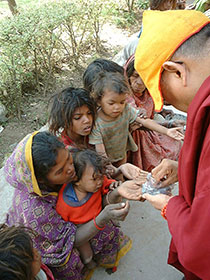- Home
- FPMT Homepage
Foundation for the Preservation of the Mahayana Tradition
The FPMT is an organization devoted to preserving and spreading Mahayana Buddhism worldwide by creating opportunities to listen, reflect, meditate, practice and actualize the unmistaken teachings of the Buddha and based on that experience spreading the Dharma to sentient beings. We provide integrated education through which people’s minds and hearts can be transformed into their highest potential for the benefit of others, inspired by an attitude of universal responsibility and service. We are committed to creating harmonious environments and helping all beings develop their full potential of infinite wisdom and compassion. Our organization is based on the Buddhist tradition of Lama Tsongkhapa of Tibet as taught to us by our founders Lama Thubten Yeshe and Lama Thubten Zopa Rinpoche.
- Willkommen
Die Stiftung zur Erhaltung der Mahayana Tradition (FPMT) ist eine Organisation, die sich weltweit für die Erhaltung und Verbreitung des Mahayana-Buddhismus einsetzt, indem sie Möglichkeiten schafft, den makellosen Lehren des Buddha zuzuhören, über sie zur reflektieren und zu meditieren und auf der Grundlage dieser Erfahrung das Dharma unter den Lebewesen zu verbreiten.
Wir bieten integrierte Schulungswege an, durch denen der Geist und das Herz der Menschen in ihr höchstes Potential verwandelt werden zum Wohl der anderen – inspiriert durch eine Haltung der universellen Verantwortung und dem Wunsch zu dienen. Wir haben uns verpflichtet, harmonische Umgebungen zu schaffen und allen Wesen zu helfen, ihr volles Potenzial unendlicher Weisheit und grenzenlosen Mitgefühls zu verwirklichen.
Unsere Organisation basiert auf der buddhistischen Tradition von Lama Tsongkhapa von Tibet, so wie sie uns von unseren Gründern Lama Thubten Yeshe und Lama Thubten Zopa Rinpoche gelehrt wird.
- Bienvenidos
La Fundación para la preservación de la tradición Mahayana (FPMT) es una organización que se dedica a preservar y difundir el budismo Mahayana en todo el mundo, creando oportunidades para escuchar, reflexionar, meditar, practicar y actualizar las enseñanzas inconfundibles de Buda y en base a esa experiencia difundir el Dharma a los seres.
Proporcionamos una educación integrada a través de la cual las mentes y los corazones de las personas se pueden transformar en su mayor potencial para el beneficio de los demás, inspirados por una actitud de responsabilidad y servicio universales. Estamos comprometidos a crear ambientes armoniosos y ayudar a todos los seres a desarrollar todo su potencial de infinita sabiduría y compasión.
Nuestra organización se basa en la tradición budista de Lama Tsongkhapa del Tíbet como nos lo enseñaron nuestros fundadores Lama Thubten Yeshe y Lama Zopa Rinpoche.
A continuación puede ver una lista de los centros y sus páginas web en su lengua preferida.
- Bienvenue
L’organisation de la FPMT a pour vocation la préservation et la diffusion du bouddhisme du mahayana dans le monde entier. Elle offre l’opportunité d’écouter, de réfléchir, de méditer, de pratiquer et de réaliser les enseignements excellents du Bouddha, pour ensuite transmettre le Dharma à tous les êtres. Nous proposons une formation intégrée grâce à laquelle le cœur et l’esprit de chacun peuvent accomplir leur potentiel le plus élevé pour le bien d’autrui, inspirés par le sens du service et une responsabilité universelle. Nous nous engageons à créer un environnement harmonieux et à aider tous les êtres à épanouir leur potentiel illimité de compassion et de sagesse. Notre organisation s’appuie sur la tradition guéloukpa de Lama Tsongkhapa du Tibet, telle qu’elle a été enseignée par nos fondateurs Lama Thoubtèn Yéshé et Lama Zopa Rinpoché.
Visitez le site de notre Editions Mahayana pour les traductions, conseils et nouvelles du Bureau international en français.
Voici une liste de centres et de leurs sites dans votre langue préférée
- Benvenuto
L’FPMT è un organizzazione il cui scopo è preservare e diffondere il Buddhismo Mahayana nel mondo, creando occasioni di ascolto, riflessione, meditazione e pratica dei perfetti insegnamenti del Buddha, al fine di attualizzare e diffondere il Dharma fra tutti gli esseri senzienti.
Offriamo un’educazione integrata, che può trasformare la mente e i cuori delle persone nel loro massimo potenziale, per il beneficio di tutti gli esseri, ispirati da un’attitudine di responsabilità universale e di servizio.
Il nostro obiettivo è quello di creare contesti armoniosi e aiutare tutti gli esseri a sviluppare in modo completo le proprie potenzialità di infinita saggezza e compassione.
La nostra organizzazione si basa sulla tradizione buddhista di Lama Tsongkhapa del Tibet, così come ci è stata insegnata dai nostri fondatori Lama Thubten Yeshe e Lama Zopa Rinpoche.
Di seguito potete trovare un elenco dei centri e dei loro siti nella lingua da voi prescelta.
- 欢迎 / 歡迎
简体中文
“护持大乘法脉基金会”( 英文简称:FPMT。全名:Foundation for the Preservation of the Mahayana Tradition) 是一个致力于护持和弘扬大乘佛法的国际佛教组织。我们提供听闻,思维,禅修,修行和实证佛陀无误教法的机会,以便让一切众生都能够享受佛法的指引和滋润。
我们全力创造和谐融洽的环境, 为人们提供解行并重的完整佛法教育,以便启发内在的环宇悲心及责任心,并开发内心所蕴藏的巨大潜能 — 无限的智慧与悲心 — 以便利益和服务一切有情。
FPMT的创办人是图腾耶喜喇嘛和喇嘛梭巴仁波切。我们所修习的是由两位上师所教导的,西藏喀巴大师的佛法传承。
繁體中文
護持大乘法脈基金會”( 英文簡稱:FPMT。全名:Found
ation for the Preservation of the Mahayana Tradition ) 是一個致力於護持和弘揚大乘佛法的國際佛教組織。我們提供聽聞, 思維,禪修,修行和實證佛陀無誤教法的機會,以便讓一切眾生都能 夠享受佛法的指引和滋潤。 我們全力創造和諧融洽的環境,
為人們提供解行並重的完整佛法教育,以便啟發內在的環宇悲心及責 任心,並開發內心所蘊藏的巨大潛能 — 無限的智慧與悲心 – – 以便利益和服務一切有情。 FPMT的創辦人是圖騰耶喜喇嘛和喇嘛梭巴仁波切。
我們所修習的是由兩位上師所教導的,西藏喀巴大師的佛法傳承。 察看道场信息:
- FPMT Homepage
- News/Media
-
- Study & Practice
-
-
- About FPMT Education Services
- Latest News
- Programs
- New to Buddhism?
- Buddhist Mind Science: Activating Your Potential
- Heart Advice for Death and Dying
- Discovering Buddhism
- Living in the Path
- Exploring Buddhism
- FPMT Basic Program
- FPMT Masters Program
- FPMT In-Depth Meditation Training
- Maitripa College
- Lotsawa Rinchen Zangpo Translator Program
- Universal Education for Compassion & Wisdom
- Online Learning Center
-
- Prayers & Practice Materials
- Overview of Prayers & Practices
- Full Catalogue of Prayers & Practice Materials
- Explore Popular Topics
- Benefiting Animals
- Chenrezig Resources
- Death & Dying Resources
- Lama Chopa (Guru Puja)
- Lama Zopa Rinpoche: Compendium of Precious Instructions
- Lama Zopa Rinpoche: Life Practice Advice
- Lama Zopa Rinpoche Practice Series
- Lamrim Resources
- Mantras
- Prayer Book Updates
- Purification Practices
- Sutras
- Thought Transformation (Lojong)
- Audio Materials
- Dharma Dates - Tibetan Calendar
- Translation Services
- Publishing Services
- Ways to Offer Support
- Prayers & Practice Materials
-
- Teachings and Advice
- Find Teachings and Advice
- Lama Zopa Rinpoche Advice Page
- Lama Zopa Rinpoche: Compendium of Precious Instructions
- Lama Zopa Rinpoche Video Teachings
- ༧སྐྱབས་རྗེ་བཟོད་པ་རིན་པོ་ཆེ་མཆོག་ནས་སྩལ་བའི་བཀའ་སློབ་བརྙན་འཕྲིན།
- Podcasts
- Lama Yeshe Wisdom Archive
- Buddhism FAQ
- Dharma for Young People
- Resources on Holy Objects
- Teachings and Advice
-
-
*If a menu item has a submenu clicking once will expand the menu clicking twice will open the page.
-
-
- Centers
-
- Teachers
-
- Projects
-
-
-
-
*If a menu item has a submenu clicking once will expand the menu clicking twice will open the page.
-
-
- FPMT
-
-
-
-
-
If you cherish another person, another sentient being, there is enlightenment and you cause them to achieve every happiness. If you don’t cherish them, there is no enlightenment for you. Therefore, this person, this one sentient being, is the most precious one in one’s own life. Therefore, what is called I needs to be let go forever. And what is called other, even one sentient being, that is to be cherished forever.
Share
Lama Zopa Rinpoche
-
-
-
- Shop
-
-
-
The Foundation Store is FPMT’s online shop and features a vast selection of Buddhist study and practice materials written or recommended by our lineage gurus. These items include homestudy programs, prayers and practices in PDF or eBook format, materials for children, and other resources to support practitioners.
Items displayed in the shop are made available for Dharma practice and educational purposes, and never for the purpose of profiting from their sale. Please read FPMT Foundation Store Policy Regarding Dharma Items for more information.
-
-
14
Training the Mind in Generosity

Overnight Praise to Tara at Losang Dragpa Centre, Selangor, Malaysia, January 2017. Photo by Gavyn Teh.
It is always a challenge for a Dharma center to balance the wish to benefit all sentient beings with the practical day-to-day needs associated with running a nonprofit organization. Funds are needed not only for the expenses of rent or a mortgage, utilities, and furnishings, but also for holy objects and offerings, practice materials, offerings to teachers, and so forth. Since it is FPMT policy that FPMT centers can charge students only a “facility fee” to cover the practical costs of organizing a teaching but cannot charge for the Dharma, FPMT centers have come up with creative solutions to keep their centers running.
The practice of generosity is fundamental to Buddhism, and it can take many forms. For most students of Dharma, offering money or belongings is a familiar way to practice generosity, or dana in Sanskrit. Many centers have developed methods to skillfully offer students opportunities for practicing generosity that support and align with the center’s efforts to share Dharma.
We invited several FPMT centers to reflect on how they sustain their centers while providing meaningful programs to the public.

Jaya Reddy, Carol Laing, Kim Lillig, Siddhi Shonibare, and Carol Vogel at Kadampa Center’s 25th Anniversary Gala, Raleigh, North Carolina, US, June 10, 2017. Photo by Doug Pitts.
Kadampa Center
Raleigh, North Carolina, US
Jill Marie, center manager
“Generosity is the most natural outward expression of an inner attitude of compassion and loving-kindness.” This quote from His Holiness the Dalai Lama speaks volumes about the model of giving at Kadampa Center.
Twenty-seven years have passed since Lama Zopa Rinpoche formally named the fledgling study group “Kadampa Center.” In 2017, we celebrated our Twenty-fifth Anniversary with a festive, fancy gala, and after gathering “Stories from the Past,” it brought to mind how our generosity model began.
Our founder, Don Brown, when asked about how we charged for classes and other programs in the early days, said, “We started with fees, then suggested donations. Since there weren’t many people to begin with, a few individuals supported the teachings because they wanted to make it happen.”
He explained, “We tried to charge for classes and visiting teachers, but it wasn’t very successful. People were way more generous than the suggested donations.”
When Bo Lozoft, a visiting teacher came in the early 1990s he suggested that if you value these teachings you vote with your pocketbook for what makes a difference for you. Joanna Smith, a founding member and first board of directors secretary commented, “Bo said he would not teach if we required a fee. He didn’t feel the Dharma should be charged for. We decided that that was a good policy and have been that way ever since.”
Gradually we moved from a “charging” culture to a “giving” culture. It didn’t happen overnight. Yes, we were apprehensive, but also optimistic. As Herb Cunningham, our first treasurer, said after we got settled, “We had packed houses all the time! More checks than I could put on a single deposit slip. We were flush. That took care of the worry about dana.”
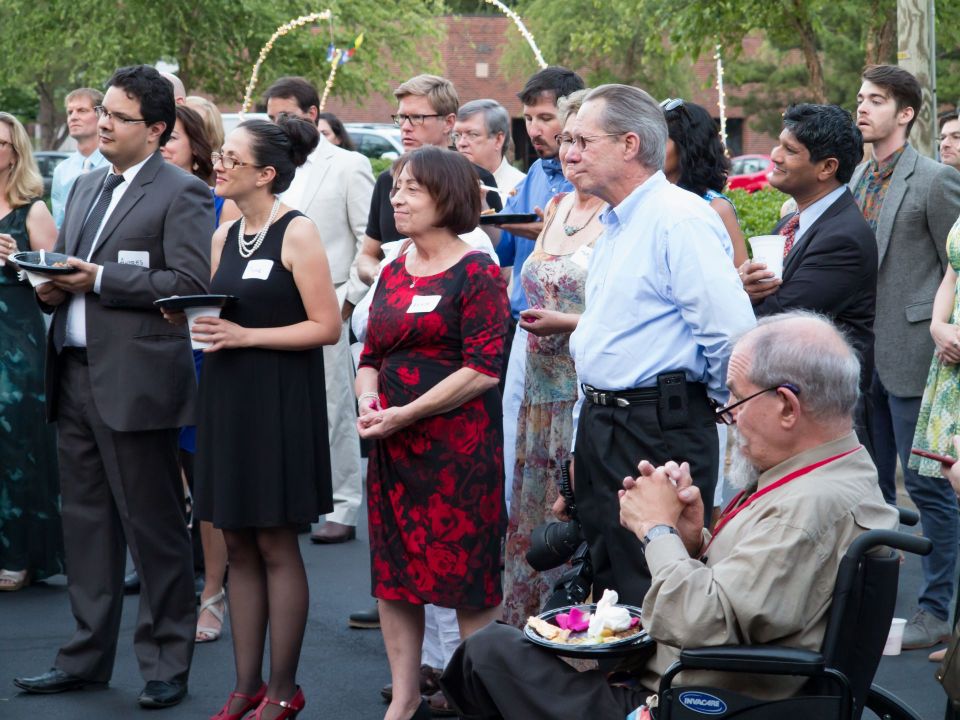
Kadampa Center’s 25th Anniversary Gala, Raleigh, North Carolina, US, June 10, 2017. Photo by David Strevel.
At one time we had gradations of membership. It didn’t work well and set a limit on giving. Eventually we created a monthly pledge plan, and that gave us confidence and reliability for continual funding.
As our center grew we needed a bigger space. To create connectivity for giving, we gathered in small groups for meals in folks’ homes to discuss our vision. We also used to show a visual pie chart of where the funds went every quarter on our wall. This seemed to help members have confidence in how their generosity was allocated.
Today we continue in our generosity model with our annual fundraising appeal that draws in sixty-five percent of our budget. The spiritual program brings in fifteen percent, and the bookstore plus the family program makes up the rest. We fundraise from time to time if we have any holes in our budget.
During our annual appeal we offer four ways of giving: financial, practice, service, and in-kind donations. This strategy helps everyone be able to practice generosity on some level, while our skits and heart talks inspire generosity on many levels. In fact, that is also the name of our financial committee, the Inspiring Generosity Committee.
To keep the generosity idea fresh during the year our center manager, Jill Marie, pops into the first night of every new class to say hello and talk about dana. Other members talk about sponsoring visiting teachers and pujas.
Many opportunities arise for inspiring generosity when specific charges are not required for classes, workshops, or retreats. While this takes more work on the side of providing information, funding categories, and creative campaigns, it keeps giving heart-based for the donors. They have options to make connections to visiting teachers, pujas, holy days, and more. The bookkeeping can become cumbersome and a little overwhelming at times, yet we love our model of generosity. We definitely challenge our “church software” technical support folks as they have never encountered as many fund codes that offer this many choices for giving. It makes tithing seem easy.
Our center thrives today: from the causes and conditions our founding members created by craving the teachings, and those who support us regularly, to our newest members who walk into the door and slip a five dollar bill into the donation box. It’s all inspiring.
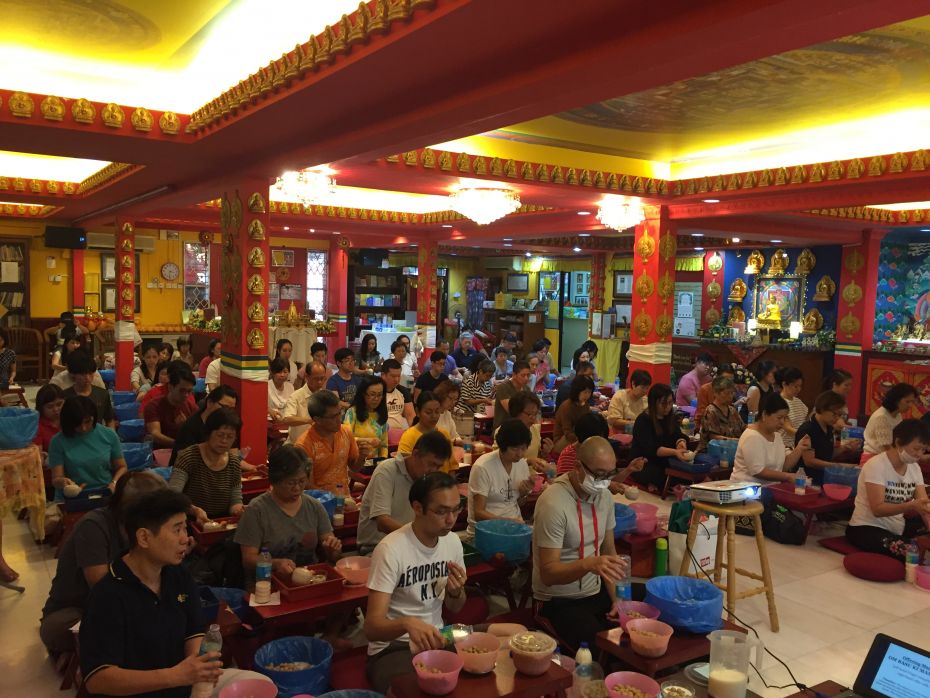
Naga Puja at Losang Dragpa Centre, Selangor, Malaysia, September 2018. Photo by Gavyn Teh.
Losang Dragpa Centre
Selangor, Malaysia
Candy Tan, spiritual program coordinator
We charge a minimal facility fee for retreats—just to cover the cost of food and utilities—but other than that Losang Dragpa Centre (LDC) has never charged for any program since the center was setup. Members know the value of Dharma, and charging a fee may not work in Asian culture.
So far our method of fundraising is working well. Members know we need funds to operate the center so they support in this way.
We do fundraising annually to achieve a certain amount to cover the center’s expenses. Proceeds (non-Dharma) from all fundraising goes to maintaining the center only.
We have a Dharma shop. We sell a variety of Dharma and non-Dharma items. The shop generates a consistent stream of income. We follow the FPMT guidelines for proceeds generated from Dharma and non-Dharma items sold in our shop. All proceeds from Dharma items goes to purchasing and the restoration of statues, printing Dharma books and materials, and more.
Asians are generally quite a generous bunch, and we find these individuals give towards and support their preferred Dharma centers. At LDC we combine the Asian culture of giving with the FPMT guidelines about how to use income from Dharma by offering sponsorship opportunities like light offerings, incense offerings, and altar and puja sponsorship to members as part of our fundraising program.
Candles are placed in the gompa for those who would like to make light offerings. We make arrangements so that members can pre-order lights and incense offerings for merit or multiplying days like Losar, Vesak, Saka Dawa, and Chinese New Year.
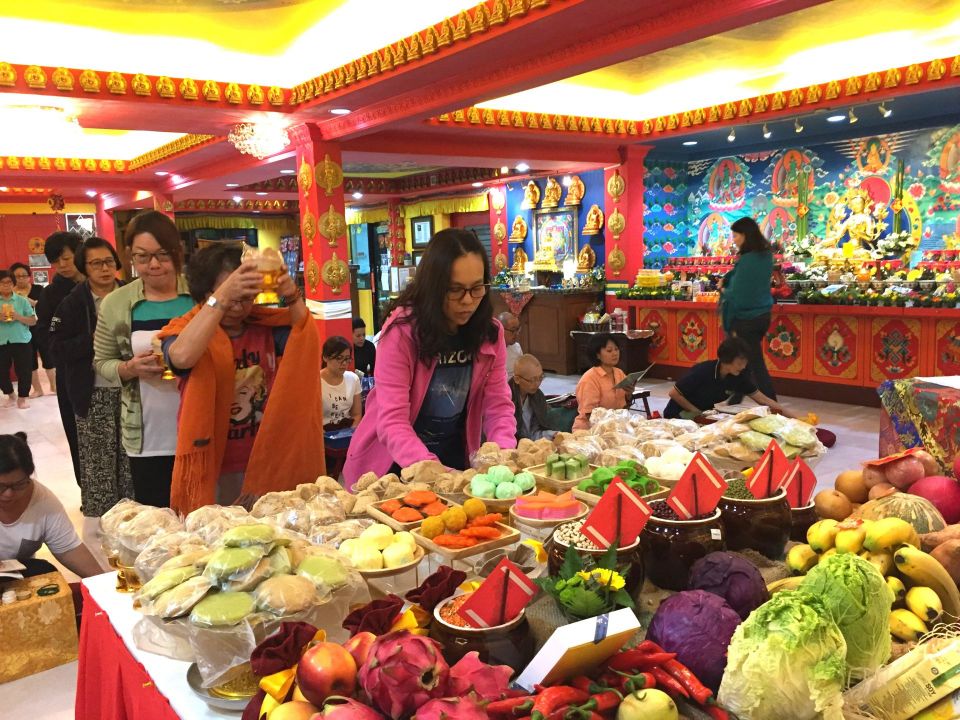
Overnight Praise to Tara at Losang Dragpa Centre, Selangor, Malaysia, February 2018. Photo by Gavyn Teh.
We offer monthly puja sponsorship opportunities. Members can make monthly or annual sponsorship contributions for Guru Pujas, Medicine Buddha Pujas, and Tara Pujas. We also offer opportunities to practice generosity by making offerings for big pujas like overnight Tara Pujas, Fire Pujas, Naga Pujas, and Jangwa Pujas.
We organize an Annual One Thousand Offering Event. It is a two-day event, conducted annually in a public hall and presided over by invited lamas. Khen Rinpoche Geshe Chonyi has been the presiding lama for the past few years. During the two-day event people can sponsor the altar and the Jangwa Puja for the deceased, and also make long life or light offerings. Additionally, people can sponsor pujas, or house or office blessings, conducted by Kopan Monastery monks.
We also make the following available for sponsorships: blessed malas, blessed mandala sets, prayer wheels, stupas, and more.
We place a list of items in our office that members can sponsor, and we also approach members for bigger items. This list can include flight tickets, hall rental and setup, flowers, and food expenses. Usually these items are incurred during big events or when a lama visits LDC.
Members also sometimes donate or sponsor items LDC needs, such as a water filter, refrigerator, or air conditioning unit for the center.
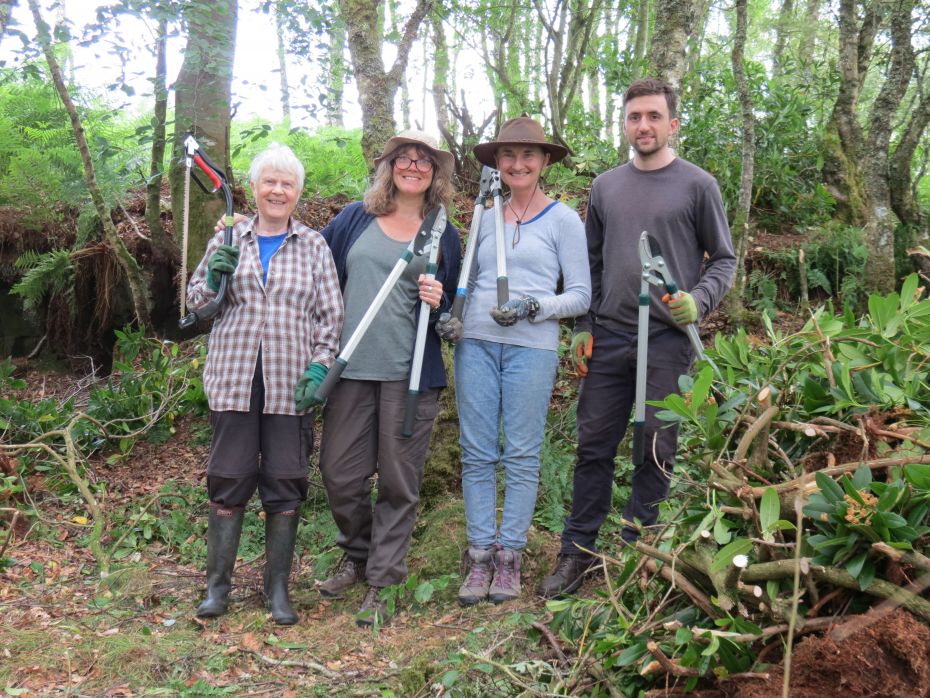
Pauline, woodland and wildlife manager, Caroline, Sally, and Michael at a woodland working party, Land of Joy, Greenhaugh, UK, July 2018. Photo courtesy of Land of Joy.
Land of Joy
Northumberland, UK
Jenny MacQueen, director
The desire to have an FPMT retreat center for the UK was a long-term vision of many people, and around ten years ago, a small group got together to make Land of Joy a reality.
We were hugely fortunate that one benefactor gave a very generous donation, sufficient for the outright purchase of a building, Greenhaugh Hall in Northumberland, a county in northeast England. This happened in September 2014. The first official retreat took place in May 2015.
Looking back at all that has happened in less than four years, it is quite amazing, culminating in a July 2018 event attended by more than seventy people—our coming of age, as it was described! Sometimes we can lose sight of our accomplishments—things seem to stand still, or even dip a bit—but “Wow, wow, wow,” as Lama Zopa Rinpoche would say.
And we all truly believe that one of the major reasons for the flourishing of this very special place is the generosity model we use, a total generosity model. Everyone connected with Land of Joy offers service as a volunteer—the live-in team, the board, the teachers—and all the other volunteers who work with us regularly or occasionally. We offer everything—teachings, accommodation, and food—freely and joyfully without expectation, as far as we are able! It’s not without its challenges, and it can be uncomfortable on both sides, but it is working and we are all totally committed to it.
The commitment and generosity of our volunteer team is an integral part of our generosity model; managing that team for the benefit of both the volunteer and the center is essential. Our live-in staff members are all volunteers, working six to eight hours a day, five days a week. We also have other regular volunteers, both local and non-local.
All live-in volunteers are provided with accommodation, meals, and basic personal toiletries. However, as an organization we are very conscious that volunteers may have additional financial needs, both short-term and long-term, and we make efforts to respond to this as far as resources and legal restrictions allow. We offer state pension contributions where applicable and contribute to attendance at teachings and retreats both at the center and elsewhere. Occasionally, we have a specific project that a volunteer can claim payment for (on a self-employed basis). In addition, retreatants often offer dana for the volunteers, and this is shared out among the whole team.
Many of our volunteers do have additional means of support such as from savings from employment, pension, or sponsorship from other sources. Some have done outside paid work via technology or very occasionally locally.
However, as the center has developed we have become aware of the need to move towards formal term agreements for both volunteer engagement and tenancy, in order that there are clear expectations and understanding of these agreements on both sides, and to encourage volunteers to be aware of the need to take personal responsibility for their situation.
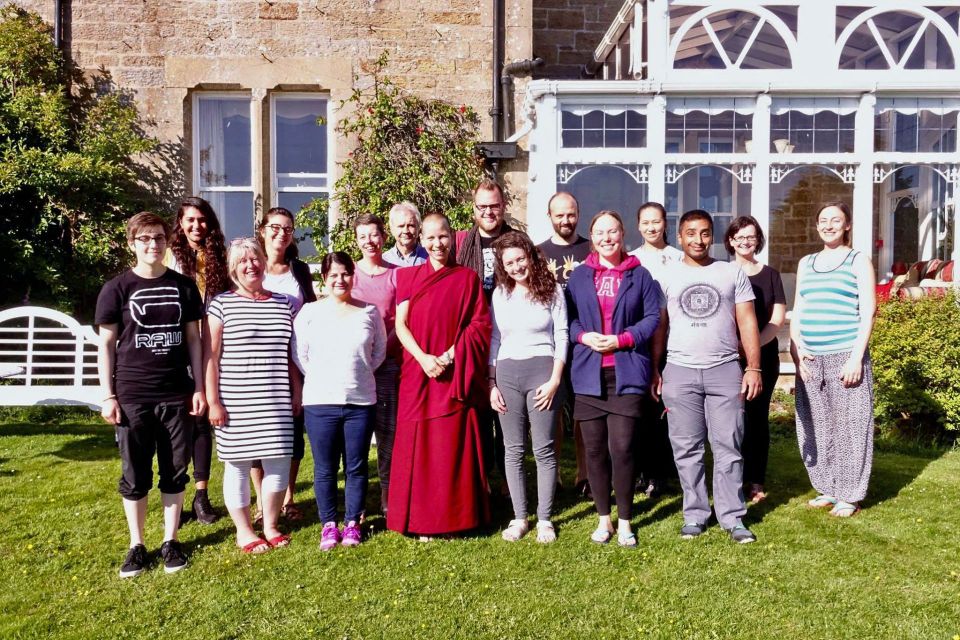
Ven. Amy Miller and students during the Meditation, Mindfulness, and Making Life Meaningful retreat at Land of Joy, Greenhaugh, UK, June 2017. Photo courtesy of Land of Joy.
Making the decision to go forward with the total generosity model did not come easily to the board. Strong arguments against it were expressed, particularly the aspect that staff were not paid. However, the board was persuaded to trial it as an experiment. The key to understanding that decision is the concept of service, so highly regarded in the FPMT organization, and the recognition that funding flows from positive spiritual potential, not the other way round.
It was helpful that the original business plan followed a traditional model of market research and used standard business model costings. This meant that the board had well-researched background information and was very aware of what funding was required for set-up and on-going costs.
We carefully monitor all income and expenditures on an on-going basis. Overall, the generosity model meets—and even exceeds—the targets of the standard business model, although every individual donation or retreat may not. That is the beauty, and challenge, of working in this way.
Our spiritual program coordinator, Beth, describes her experience of the model in the following way: “Implementing a generosity model requires open-heartedness and trust. It regularly challenges my thoughts and actions through redefining what I see as being sincerely generous. It gives me the chance to see how limited my ideas surrounding it are and the chance to go beyond them.
“It has enabled me to see how generosity can manifest in many different ways—not just through money but through kindness, time and effort, and compassion—and that these different forms of generosity are equally as generous and should be celebrated equally. It has given others and myself the precious chance to become more willing to give. It’s liberating and inspiring.”
Adopting a radical model as an organization is one thing. Convincing others to accept it is another. For many people in the West, the concept is totally alien.
We are frequently asked, “But what is the suggested donation?” or “How do I know how much to give?” The idea of giving too much appears to be as challenging as giving too little.
The reality is that it is very simple to come up with a realistic amount just by looking up the prices at other retreat centers. The much harder question is, “What does generosity mean to me?” That can be uncomfortable, but that is Dharma in action—mind transformation.
Ven. Mary Reavey, a regular teacher at Land of Joy who has been involved from the early stages, had her doubts as to how the model would work. Now she says, “I have seen this generosity model generate waves of altruism, directly combating selfishness. No wonder it’s the first step on the path of a Bodhisattva.”
Then again, there is a perception in the West that if something is not priced high, then it is not of much value. Andy Wistreich, a key member of the original founders expresses our response to that perception in this heart-warming way: “If there is a vestige of it in people’s minds before they come, this is quickly melted by the warm, welcoming, generous energy that greets them on arrival, and continues throughout their stay. This energy is in every meal, every cup of tea, and in every experience of walking in the woods, enjoying a hot shower, sitting by the fire in the sitting room, or helping in the garden.
“Simply Dharma is a joyful practice. Retreat from the ordinary world is retreat into Dharma, which transcends ordinary boundaries. We try to reflect that in the way we relate to people.” What about the future? Up until now, we have mainly offered group retreats. Now, we are moving into phase two of our long-term plan, offering facilities for personal retreat.
We have converted an old coach house, creating three modern, en-suite rooms plus a new meeting room, and a gompa where a fourteen-foot high high Kurukulla will dance as advised by Lama Zopa Rinpoche. We will also have three retreat huts in place on the grounds this year. We will offer all of these new facilities on that same generosity model.
Our income currently comes from retreat donations, supplemented by regular and one-off donations from supporters. These cover our overall outgoing costs and generate a small surplus. We also fundraise for specific projects—largely from individuals, but also from various funding bodies.
However, Greenhaugh Hall is an old building with high maintenance costs. Going forward we will have to consider developing income generation streams beyond our current methods.
Our commitment to the generosity model not only remains strong, it is gaining in strength. Working with the total generosity model creates an energy very different from normal transactions—a real and ongoing connection, that “pamily peeling” that FPMT founder Lama Yeshe often talked about. It also encompasses everything that we and our supporters give, way beyond money—time, practices, mantras, just being here and taking part, giving with a good heart, dedicating the merits to all sentient beings. This creates the merit and the causes and conditions for Land of Joy to flourish for eons to come.
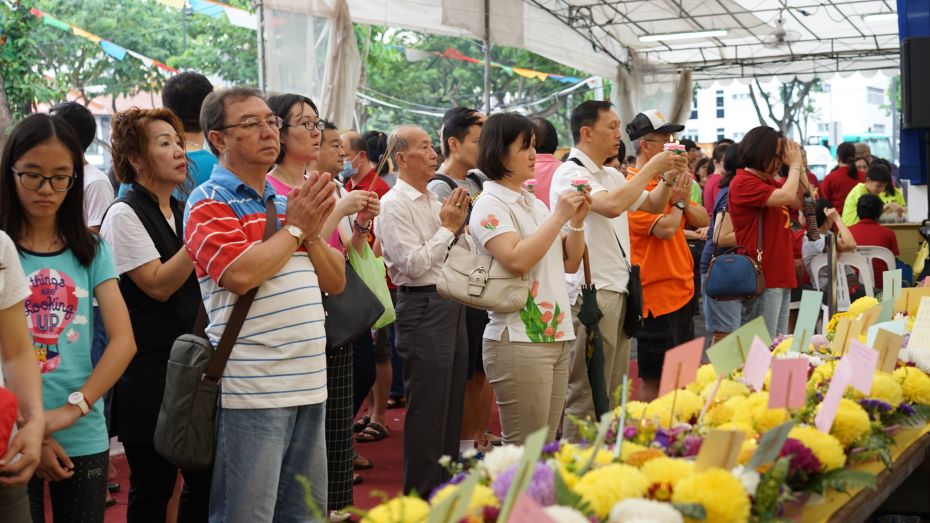
Vesak Celebration, Amitabha Buddhist Centre, Singapore, May 2017. Photo by Tan Seow Kheng.
Amitabha Buddhist Centre
Singapore
Cecilia Tsong, long-time student, active ABC member and volunteer
Amitabha Buddhist Centre (ABC)’s success in fundraising and Dharma propagation has its roots in the guidance and advice we receive from Kyabje Lama Zopa Rinpoche. We are also fortunate to have a long-serving, well-liked center director, Tan Hup Cheng, who seems to have the Midas touch when it comes to sourcing for financial support.
It helps too, that ABC is in a cultural environment where many have faith in the Triple Gem and believe in the benefit of making offerings to temples and Dharma centers, commissioning holy objects, as well as supporting Dharma publications and various Buddhist initiatives.
As part of their cultural values, Chinese people have a strong belief in the law of cause and effect, even though they may not necessarily be practicing Buddhists. Often, they will support temples, Dharma activities, and ordained Sangha with funds so that they may enjoy prosperity and happiness in this life.
Through a better understanding of the Dharma by attending teachings at ABC, students learn that generosity can be practiced in other ways: offering service to the center, participating in animal liberation activities to protect the lives of animals, and sharing their understanding of the Dharma with newer students.
ABC’s main fundraising drive takes place every year on Vesak Day, a public holiday in Singapore. This is a time when the general public is inclined to make offerings as a way of remembering the kindness of Shakyamuni Buddha and requesting his blessings for a life well-lived.
Mindful that Dharma is priceless, local Buddhist centers and temples offer Dharma teachings free of charge. However, ABC does levy a nominal charge for Nyung näs and one-day retreats to cover the costs of meals, refreshments, and altar offerings. ABC also organizes pilgrimages and retreats overseas, and every effort is made to keep prices low. For these activities, there is differential pricing for ABC and non-ABC members.
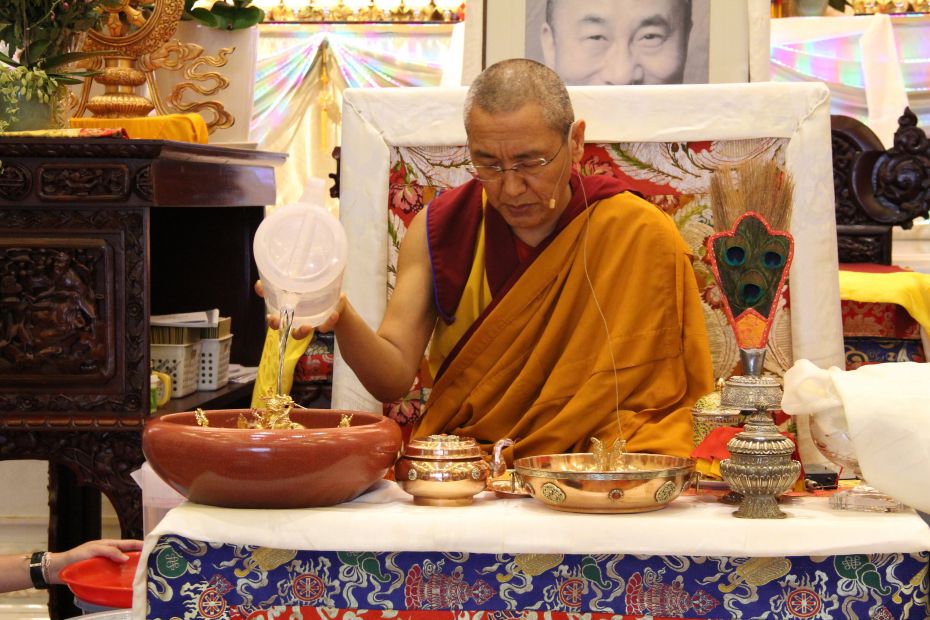
FPMT resident geshe Khen Rinpoche Geshe Chonyi during an Ullambana puja at Amitabha Buddhist Centre, Singapore, August 2014. Photo by Noelle Teoh.
Apart from Vesak Day programs, ABC has developed special Dharma events over the years to bring more people to the center. The Medicine Buddha Dharma celebration, Most Secret Hayagriva puja, and Ullambana puja are popular and have been attracting a growing group of participants each year. Corporate sponsorships are available for these pujas, an option that appeals greatly to local business people.
For those who love all things beautiful we have a well-curated collection of Dharma objects—statues, malas, offering bowls, prayer wheels, prayer flags, incense, thangkas, and so forth—that are available at our Tashi Delek retail store. This generates additional income that is pumped back into serving the center’s needs.
In its fundraising activities—including its Dharma shop—ABC is fastidious in making sure that these funds are used in accordance with the donors’ wishes. Also, when holy objects are sponsored from the Dharma shop, such income is directed to supporting the maintenance and building fund of the center, and not to the support of the Sangha as such.
Lastly, as an on-going fundraising drive, ABC runs a program of electronic debit sponsorships where people can choose to have regular deductions made from their bank accounts.
There are also donation boxes in the center for our building and maintenance fund, Sangha fund, publications, animal liberation, puja fund, and general funds. Visitors are free to drop their offerings—and say a silent prayer in the sacred ambiance of the merit-field—while recalling the words of Lama Zopa Rinpoche in The Four Noble Truths: A Guide for Everyday Life, “Be as generous as we can to benefit the poor and sick. Make offerings to holy objects and other living beings, and dedicate this generosity for the happiness and enlightenment of all beings. Doing so offers great release to our minds.”
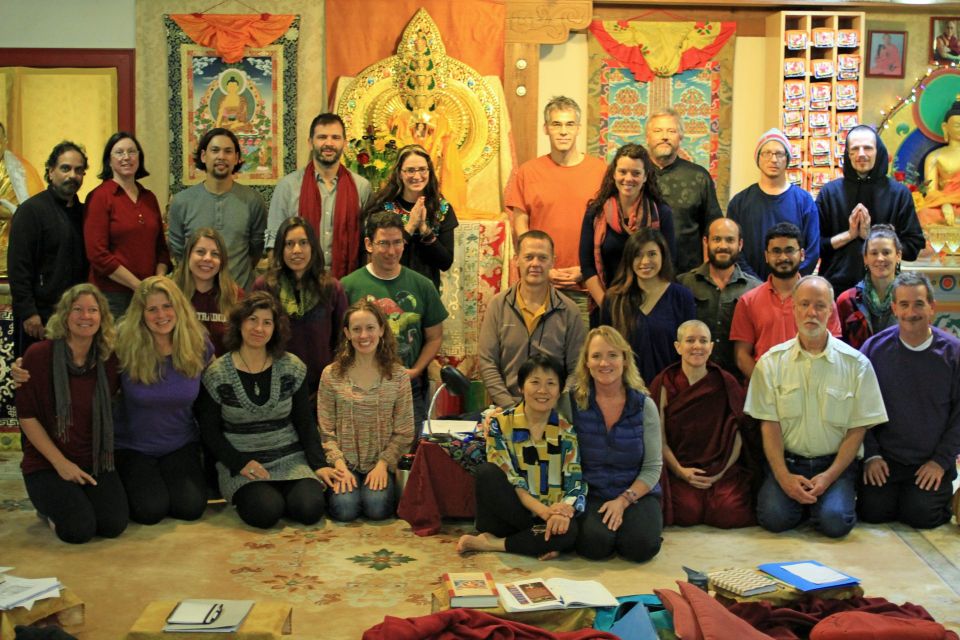
Pay-It-Forward Kopan West lamrim retreat led by Glen Svensson at Vajrapani Institute, Boulder Creek, California, US, November 2014. Photo by Glendon Papa.
Vajrapani Institute
Boulder Creek, California, US
Ven. Fabienne Pradelle, former director
For years we’ve been battling with ways to make our retreats financially accessible to all, so that money would not come in the way of people being able to experience retreat. In this quest we tried so many different things, such as sliding scales or making scholarships opportunities very visible on the retreat registration pages.
Our success was limited. While some people would apply for scholarships many didn’t, thinking they would take away from a Dharma center.
Then in 2013, we started exploring a different model, Pay-It-Forward. Pay-It-Forward is different from the dana model where people make a donation towards their retreat.
Retreats offered at Vajrapani Institute on the Pay-It-Forward model are free, totally free. There is a deposit—which is non-refundable if you don’t show up—just to minimize the amount of no-shows and empty beds.
Whatever people offer towards Pay-It-Forward goes towards sponsoring future retreats. People get to experience being here thanks to the kindness of strangers who offered money to make it possible for them to be here.
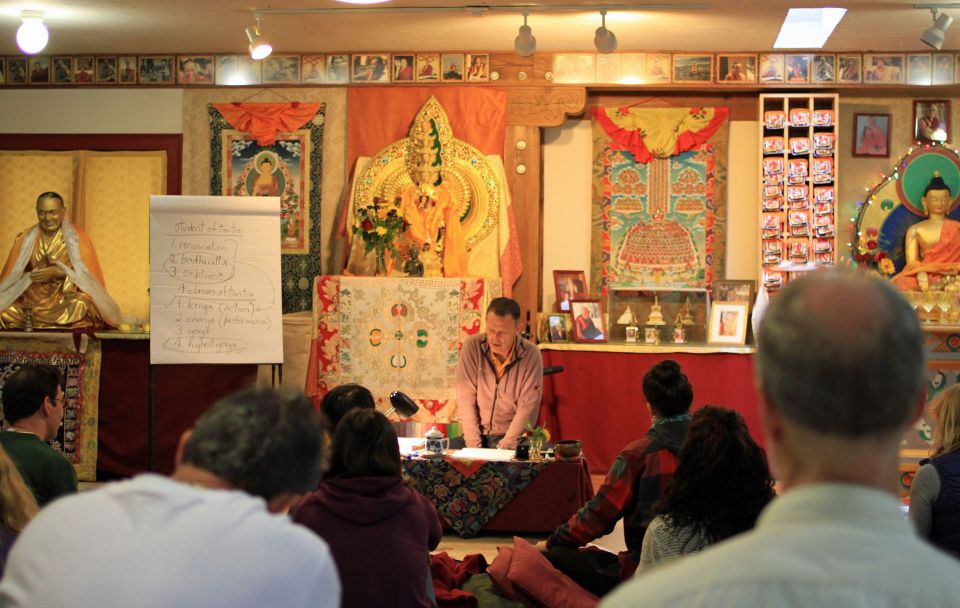
Pay-It-Forward Kopan West lamrim retreat led by Glen Svensson at Vajrapani Institute, Boulder Creek, California, US, November 2014. Photo by Glendon Papa.
This may sound like semantics. A cynic could ask, “Well, aren’t they really paying for what they receive?” The answer is it’s not semantics.
It’s extremely valuable for participants to experience being the recipient of other’s generosity. And out of that space, to have the wish to make it possible for others to have that experience—to sponsor not ourselves, but others who will never know who we are, and will never thank us. There is so much richness in those experiences.
We have found that this Pay-It-Forward model has increased the social diversity of participants. We see more people who are between jobs, single parents, students, and so forth. We see people who normally wouldn’t be able to access those retreats.
A quarter of our retreats are now offered on a Pay-It-Forward model. Our hope is to be able to offer more on this model in the coming years. Virtue begets virtue, and who knows who may be inspired to help us make this possible in the future!
For more information about Amitabha Buddhist Centre, visit their website:
http://www.fpmtabc.org/
For more information about Losang Dragpa Centre, visit their website:
http://www.fpmt-ldc.org/
For more information about Kadampa Center, visit their website:
https://kadampa-center.org/
For more information about Land of Joy, visit their website:
http://landofjoy.co.uk/
For more information about Vajrapani Institute, visit their website:
https://vajrapani.org/
- Home
- News/Media
- Study & Practice
- About FPMT Education Services
- Latest News
- Programs
- New to Buddhism?
- Buddhist Mind Science: Activating Your Potential
- Heart Advice for Death and Dying
- Discovering Buddhism
- Living in the Path
- Exploring Buddhism
- FPMT Basic Program
- FPMT Masters Program
- FPMT In-Depth Meditation Training
- Maitripa College
- Lotsawa Rinchen Zangpo Translator Program
- Universal Education for Compassion & Wisdom
- Online Learning Center
- Prayers & Practice Materials
- Overview of Prayers & Practices
- Full Catalogue of Prayers & Practice Materials
- Explore Popular Topics
- Benefiting Animals
- Chenrezig Resources
- Death & Dying Resources
- Lama Chopa (Guru Puja)
- Lama Zopa Rinpoche: Compendium of Precious Instructions
- Lama Zopa Rinpoche: Life Practice Advice
- Lama Zopa Rinpoche Practice Series
- Lamrim Resources
- Mantras
- Prayer Book Updates
- Purification Practices
- Sutras
- Thought Transformation (Lojong)
- Audio Materials
- Dharma Dates – Tibetan Calendar
- Translation Services
- Publishing Services
- Teachings and Advice
- Find Teachings and Advice
- Lama Zopa Rinpoche Advice Page
- Lama Zopa Rinpoche: Compendium of Precious Instructions
- Lama Zopa Rinpoche Video Teachings
- ༧སྐྱབས་རྗེ་བཟོད་པ་རིན་པོ་ཆེ་མཆོག་ནས་སྩལ་བའི་བཀའ་སློབ་བརྙན་འཕྲིན།
- Podcasts
- Lama Yeshe Wisdom Archive
- Buddhism FAQ
- Dharma for Young People
- Resources on Holy Objects
- Ways to Offer Support
- Centers
- Affiliates Area
- Teachers
- Projects
- Charitable Projects
- Make a Donation
- Applying for Grants
- News about Projects
- Other Projects within FPMT
- Support International Office
- Projects Photo Galleries
- Give Where Most Needed
- FPMT
- Shop
Translate*
*powered by Google TranslateTranslation of pages on fpmt.org is performed by Google Translate, a third party service which FPMT has no control over. The service provides automated computer translations that are only an approximation of the websites' original content. The translations should not be considered exact and only used as a rough guide.Without understanding how your inner nature evolves, how can you possibly discover eternal happiness? Where is eternal happiness? It’s not in the sky or in the jungle; you won’t find it in the air or under the ground. Everlasting happiness is within you, within your psyche, your consciousness, your mind. That’s why it’s important that you investigate the nature of your own mind.







